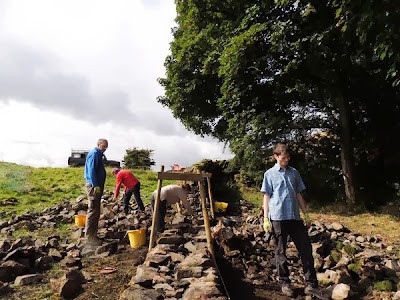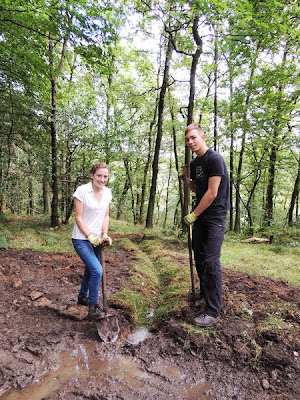Every year, thousands of young trees are planted all across the country in lightweight plastic tubes which vary in height depending on the species being planted and what they need protecting from. After a few years these tubes need removing but this can damage the tree, unless you have the secret weapon!
Why Use Them in the First Place?
There are a wide variety of tubes available; shorter ones measuring 18" high protect shrubs from rabbits or mice which may nibble at the soft bark and tubes up to 6ft high give the trees a fighting chance of growing tall without having their tops eaten off.
The tubes serve another purpose, which is to provide a micro-habitat for the tree as the air temperature inside will be slightly warmer and more humid than outside the tube. By protecting the very thin cambium of sapling trees from icy cold winds, the tubes are therefore ideal for use when planting in exposed locations.
| Hundreds of native oak planted here on an exposed site have enjoyed the protection offered by simple plastic tubes |
The Drawback from Using Tubes
The tubes are designed to split open and fall off the tree when it grows larger; some tubes come already perforated to allow for this. However, in practice the tubes don't often fall off on their own and in fact can cause serious damage to a tree which has grown healthily for a few years. So many people go to the effort of planting trees; yet I often see them looking quite sorry for themselves and at worst strangled by the tubes that once saved them as tiny whips.
As the tree grows it fills the gap inside the tube and this becomes a trap for debris such as dead leaves. When the tree has nearly filled the tube this rotting debris will hold water like a sponge up against the outer surface of the tree and can cause it to rot. When tubes are taken off at this point the tree is often covered in thick green algae!
| This guard has been on too long, moss and even an ants nest were found within! |
The other problem is that trees are usually wider at the base than the top, so at a quick glance the tree can appear to have plenty of room for growth at the top. However, the base may have grown to completely fill the plastic tube which is now collecting rainwater as well as the usual plant debris.
The challenge when the trees get to this stage is to remove the plastic tube without causing damage to the soft outer bark of the saplings, but if the tubes are completely filled by the tree then how can we do this? A regular knife will cut through the plastic and into the bark leaving a wound that will put the tree in danger of fungal infection.
The Secret Solution!
A simple hand tool used for opening cardboard boxes! Many different types are available. The one I use has a metal blade that can be rotated and replaced as it gets worn or damaged. The method is to simply start as the top and carefully slide the beak of the tool between the tree and the guard and the blade cuts the tube. Sometimes it's difficult to get to the very bottom so I try and lift the plastic tube up the tree until I have enough room to continue cutting to the very bottom. Once the tube has been cut all the way down, it's a simple case of detaching it from the supporting post and removing it from the woodland.
| A plastic tool intended for opening boxes has another great use |
| Simple but effective. Also safe for the tree and the operator! |
Sometimes there is a need to cut the tube open but leave it on the tree. When shedding antlers, deer will sometimes rub them on the young trees causing terrible damage. The other advantage is that the tree has more room to sway in winds, giving it the need to put on better and stronger supporting roots, so when the guard is finally taken off the tree is less likely to flop to the floor! From experience, using wider tubes meant for shrubs but placing one on top of another works best for individual open grown trees, as they have plenty of room, perhaps a little more light and yet are still well protected.
When planting hundreds of trees, there are usually a few that don't survive and leave empty tubes standing. These can be re-used, if not in situ, then they can be taken away and used again when the next planting season comes around.
| Look for tubes with a fluted top; this stops the tree from ring-barking itself on a sharp edge. |
So if you've planted trees in tubes, please don't forget to check up on them regularly, as this may save them.
Ben Knipe
Woodland Ranger





